Structural and Efficiency Effects of Land Transfers on Food Planting: A Comparative Perspective on North and South of China
Abstract
:1. Introduction
2. Literature Review
3. Analysis of the Differences between Land Transfer and Food Planting
4. Variables and Models
4.1. Description of Data and Variables
4.2. Methods and Models
5. Analysis of the Empirical Results
6. Robustness Test
6.1. Robustness Test: Differences-in-Differences
6.2. Robustness Test: Changing the Time Window
7. Conclusions and Recommendations
- (1)
- Land transfer reduces the planting of food crops and leads farmers to shift to the planting of cash crops.
- (2)
- There is regional heterogeneity in the impact of land transfers on the grain planting structure. The shift away from planting grains is more prominent in the south than in the north. Land transfer reduced wheat cultivation in the north and rice cultivation in the south.
- (3)
- Land transfer has increased the operating income of farmers, and the income of farmers in the north is higher than that in the south.
- (4)
- Land transfer among farmers is mainly small-scale transfer, which does not improve the efficiency of farmers’ grain planting.
Author Contributions
Funding
Institutional Review Board Statement
Informed Consent Statement
Data Availability Statement
Conflicts of Interest
References
- Shang, X.; Zhu, S. Analysis on the effect of agricultural land transfer subsidy policy—Based on crowding out effect, government rent creation and target deviation. China Rural Obs. 2017, 6, 43–56. [Google Scholar]
- Zhai, L.; Xia, X.; Wu, A. The impact of farmland transfer on Farmers’ livelihood capital under different government intervention scenarios: An econometric analysis based on psm-did. China Rural Econ. 2017, 2, 2–15. [Google Scholar]
- Pranay, R.; Chloe, B.W.; Francis, R.E.; Sheila, M.W.R.; Linda, S.P. Understanding barriers and opportunities for adoption of conservation practices on rented farmland in the US. Land Use Policy 2019, 80, 214–223. [Google Scholar]
- He, X.; Jiang, T.; Guo, L.; Gan, L. Research on the development of China’s farmland transfer market and farmers’ Farmland Transfer Behavior—Based on the survey data of 29 provinces from 2013 to 2015. Manag. World 2016, 6, 79–89. [Google Scholar]
- Zhu, W.; Luo, B. Farmland price illusion: The “failure” of farmland transfer market allocation caused by the difference of value evaluation—Based on the micro data of farmers in 9 provinces (regions) in China. China Rural Obs. 2018, 5, 67–81. [Google Scholar]
- Tian, C.; Fang, L. Land adjustment and farmland leasing market: A dual perspective based on quantity and quality. Econ. Res. 2013, 48, 110–121. [Google Scholar]
- Wang, Y.; Li, X.; Li, W.; Tan, M. Land titling program and farmland rental market participation in China: Evidence from pilot provinces. Land Use Policy 2018, 74, 281–290. [Google Scholar] [CrossRef]
- Xu, Z.; Tan, X.; Zheng, X.; Lu, W. Influence and constraint conditions of farmland transfer market development on grain production. China Rural Econ. 2017, 9, 26–43. [Google Scholar]
- Gao, L.; Huang, J.; Rozelle, S.; Xu, Z. The development of China’s farmland transfer market and its impact on Farmers’ Investment. Economics 2011, 10, 1499–1514. [Google Scholar]
- Heidi, L.; Marianne, P.; Klaus, S. Do farmers care about rented land? A multi-method study on land tenure and soil conservation. Land Use Policy 2019, 82, 228–239. [Google Scholar]
- Ma, X.; Qiu, T.; Qian, Z. Security of farmland property rights and farmers’ participation in farmland transfer market: An Empirical Analysis Based on survey data of Jiangsu, Hubei, Guangxi and Heilongjiang provinces. China Rural Econ. 2015, 2, 22–37. [Google Scholar]
- Lin, W.; Qin, M.; Su, Y.; Wang, Z. How does the new round of farmland ownership affect farmland transfer?—Evidence from China’s health and pension follow-up survey. China Rural Econ. 2017, 7, 29–43. [Google Scholar]
- Xu, Q.; Liu, J.; Qian, Y. Labor mobility, farmland ownership and farmland transfer. Agric. Technol. Econ. 2017, 5, 4–16. [Google Scholar]
- Luo, M.; Xu, Q.; Lu, Y. Non agricultural employment, social security function of land and farmland transfer. China Popul. Sci. 2018, 5, 30–41, 126–127. [Google Scholar]
- Luo, B. Coase Theorem: Reflection and expansion: On the reform and selection of China’s farmland transfer system. Econ. Res. 2017, 52, 178–193. [Google Scholar]
- Qiu, T.; Luo, B. Will farmland adjustment inhibit the non-agricultural transfer of rural labor force? China Rural Obs. 2017, 4, 57–71. [Google Scholar]
- Wang, Q.; Ren, Q.; Yu, J. Empirical analysis on the bargaining power of farmers in major grain producing areas. China Rural Obs. 2018, 2, 47–59. [Google Scholar]
- Ayala, W.; Thomas, S.J. Land Prices Heading Skyward? An Analysis of Farmland Values across Tanzania. Appl. Econ. Perspect. Policy 2018, 40, 187–214. [Google Scholar]
- Li, T.; Zhao, Y.; Xin, X. Analysis of basic characteristics and influencing factors of current farmland transfer. China Rural Econ. 2009, 10, 4–11. [Google Scholar]
- Hou, J.; Huo, X. Credit availability, financing scale and farmers’ Farmland Transfer: A case study of specialized farmers. China Rural Obs. 2016, 6, 29–39. [Google Scholar]
- Ani, L.K.; Mary, C.A. Dynamics of Farmland Ownership and Leasing: Implications for Young and Beginning Farmers. Appl. Econ. Perspect. Policy 2016, 38, 334–350. [Google Scholar]
- Su, L.; He, X.; Kong, R. The impact of financial knowledge on Farmers’ Farmland Transfer Behavior: An analysis based on the regulatory effect of farmland confirmation certificate. China Rural Econ. 2018, 8, 17–31. [Google Scholar]
- TrieuHuy, H.; ThanhNguyen, T. Cropland rental market and farm technical efficiency in rural Vietnam. Land Use Policy. 2019, 81, 408–423. [Google Scholar]
- Deininger, K.; Jin, S. The potential of land rental markets in the process of economic development: Evidence from China. J. Dev. Econ. 2005, 78, 241–270. [Google Scholar] [CrossRef]
- Tan, S.; Zhang, R.; Tan, Z. Grassland rental markets and herder technical efficiency: Ability effect or resource equilibration effect? Land Use Policy 2018, 77, 135–142. [Google Scholar] [CrossRef] [Green Version]
- Chen, H.; Shi, Q.; Gu, H. Is rural land transfer efficient? Taking Shanxi as an example. China Rural Econ. 2014, 7, 61–71. [Google Scholar]
- Chamberlin, J.; Ricker-Gilbert, J. Participation in Rural Land Rental Markets in Sub-Saharan Africa: Who Benefits and by How Much? Evidence from Malawi and Zambia. Am. J. Agric. Econ. 2016, 98, 1507–1528. [Google Scholar] [CrossRef] [Green Version]
- Qian, L.; Hong, M. Non agricultural employment, land transfer and agricultural production efficiency change: An Empirical Analysis Based on CFPS. China Rural Econ. 2016, 12, 2–16. [Google Scholar]
- Zeng, Y.; Lv, Y.; Liu, W. Does farmland transfer improve the technical efficiency of grain production—From the perspective of farmers. Agric. Technol. Econ. 2018, 3, 41–55. [Google Scholar]
- Jin, S.; Jayne, T.S. Land Rental Markets in Kenya: Implications for Efficiency, Equity, Household Income, and Poverty. Land Econ. 2013, 89, 246–271. [Google Scholar] [CrossRef]
- Ito, J.; Nishikori, M.; Toyoshi, M.; Feuer, H.N. The contribution of land exchange institutions and markets in countering farmland abandonment in Japan. Land Use Policy 2016, 57, 582–593. [Google Scholar] [CrossRef]
- Jin, S.; Deininger, D. Land rental markets in the process of rural structural transformation: Productivity and equity impacts from China. J. Comp. Econ. 2009, 37, 629–646. [Google Scholar] [CrossRef] [Green Version]
- Feng, S.; Heerink, N.; Ruben, R.; Qu, F. Land rental market, off-farm employment and agricultural production in Southeast China: A plot-level case study. China Econ. Rev. 2010, 21, 598–606. [Google Scholar] [CrossRef]
- Feng, S. Land rental, off-farm employment and technical efficiency of farm households in Jiangxi Province. China. NJAS Wagening. J. Life Sci. 2008, 55, 363–378. [Google Scholar] [CrossRef] [Green Version]
- Koirala, K.H.; Mishra, A.; Mohanty, M. Impact of land ownership on productivity and efficiency of rice farmers: The case of the Philippines. Land Use Policy 2016, 50, 371–378. [Google Scholar] [CrossRef]
- Liu, Y.; Yan, B.; Wang, Y.; Zhou, Y. Will land transfer always increase technical efficiency in China?—A land cost perspective. Land Use Policy 2019, 82, 414–421. [Google Scholar] [CrossRef]
- Deininger, D.; Jin, S.; Nagarajan, H.K. Efficiency and equity impacts of rural land rental restrictions: Evidence from India. Eur. Econ. Rev. 2008, 52, 892–918. [Google Scholar] [CrossRef] [Green Version]
- Wang, X.; Cao, T.; Zou, W. Impact of local government intervention on agricultural land transfer on production efficiency: An analysis based on rice growers. China Popul. Resour. Environ. 2018, 28, 133–141. [Google Scholar]
- Yi, X.; Chen, Y. Analysis on Influencing Factors of farmers’ transfer to cultivated land and their “non grain” planting behavior and scale—Based on the survey data of farmers in Zhejiang and Hebei provinces. China Rural Obs. 2010, 6, 2–10. [Google Scholar]
- Wang, T.; Luri, M.; Janssen, L.; Hennessy, D.A.; Feng, H.; Wimberly, M.C.; Arorae, G. Determinants of Motives for Land Use Decisions at the Margins of the Corn Belt. Ecol. Econ. 2017, 134, 227–237. [Google Scholar] [CrossRef] [Green Version]
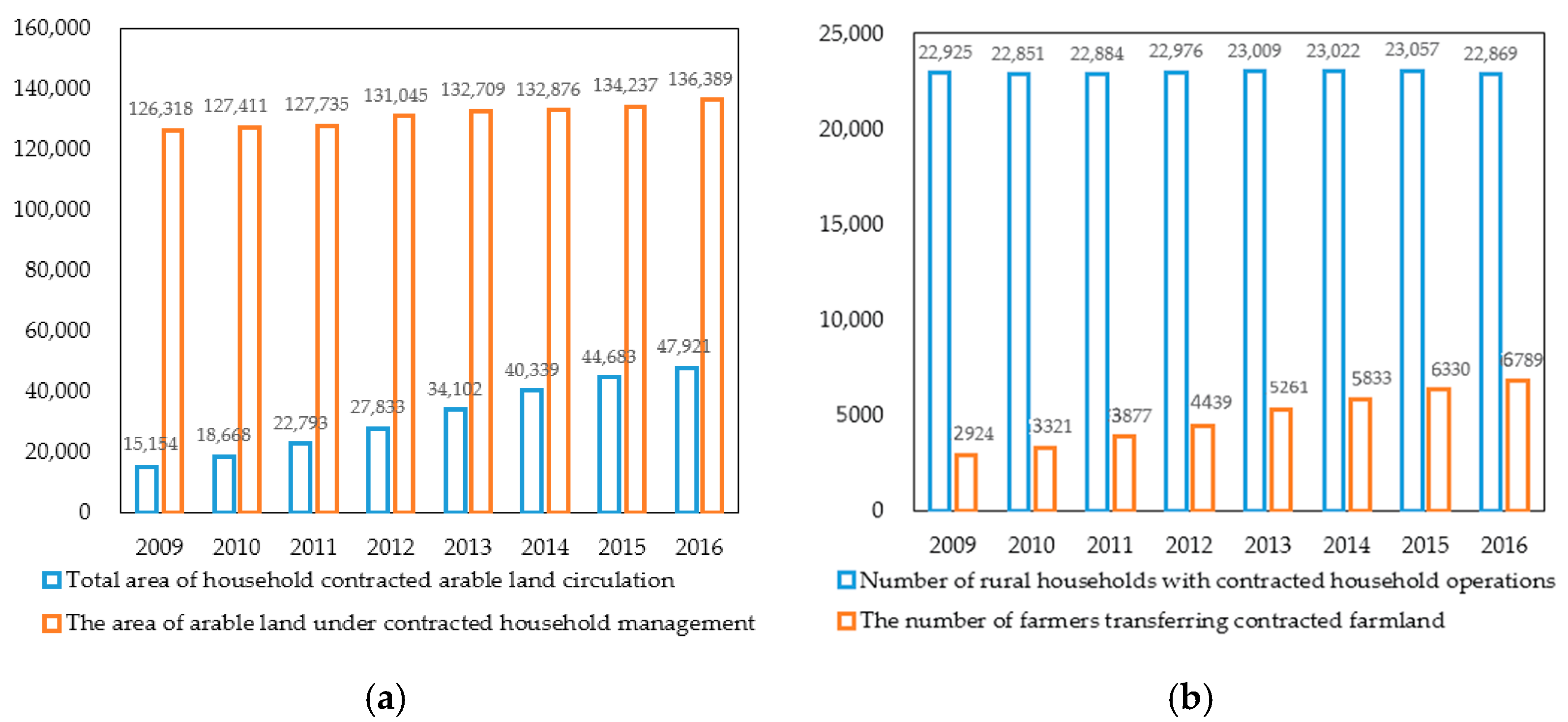
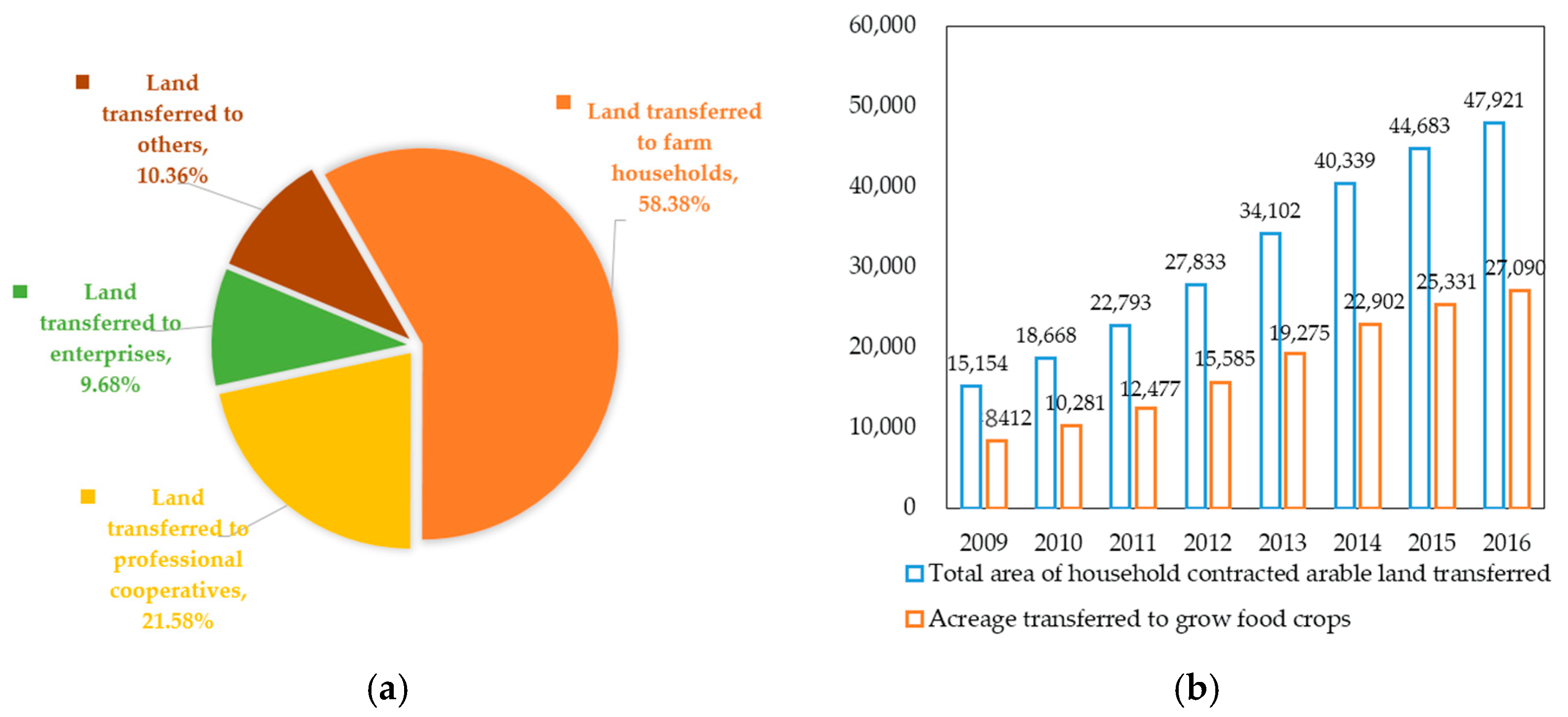
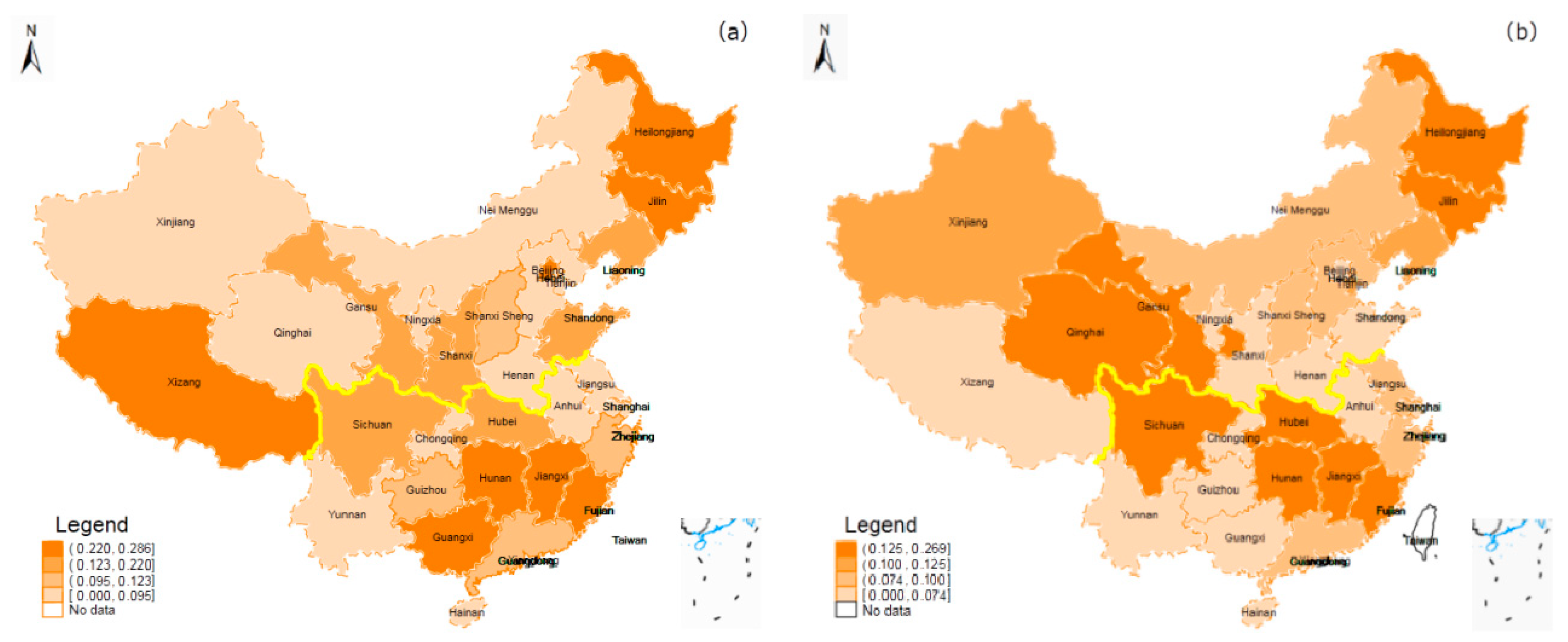
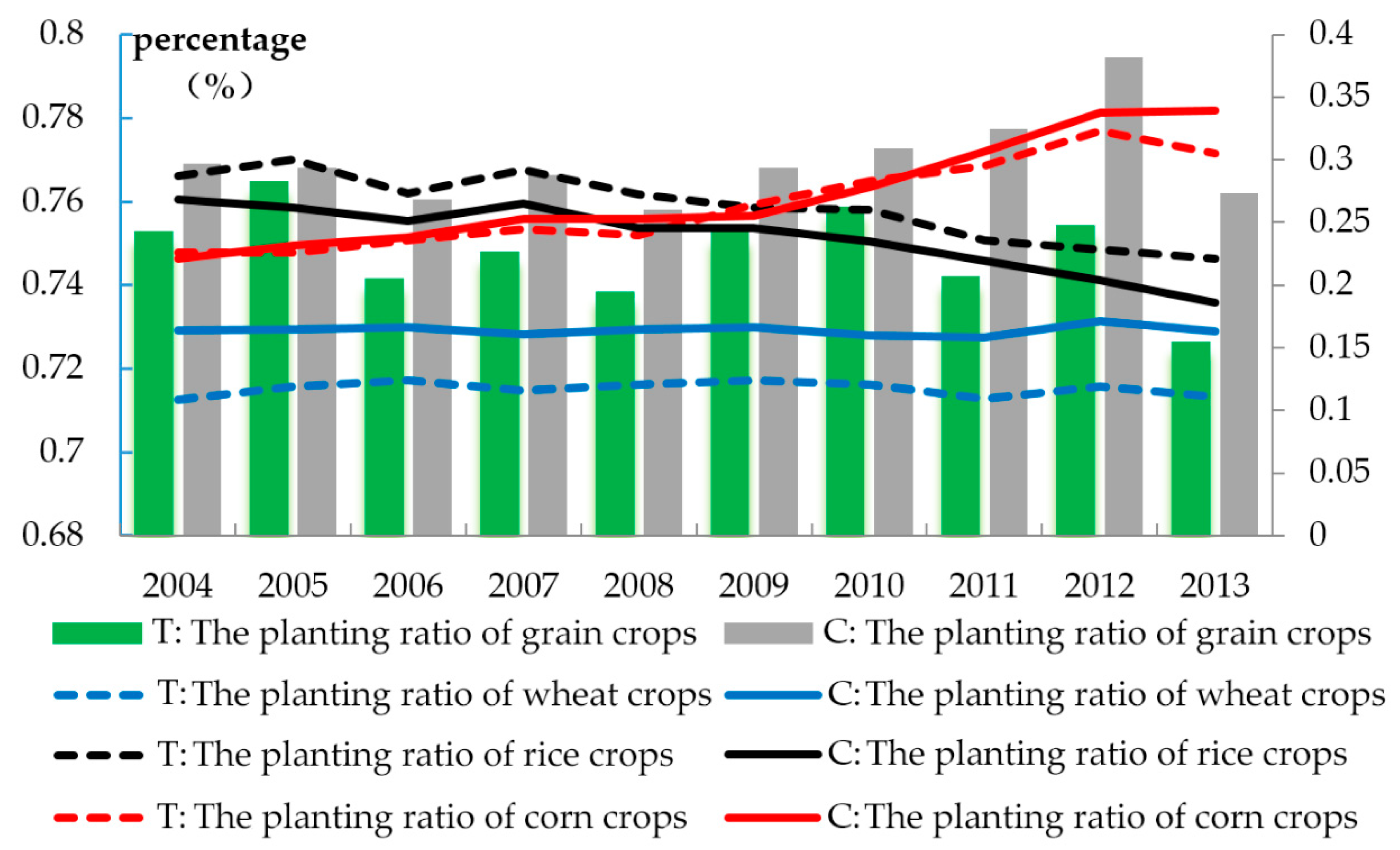
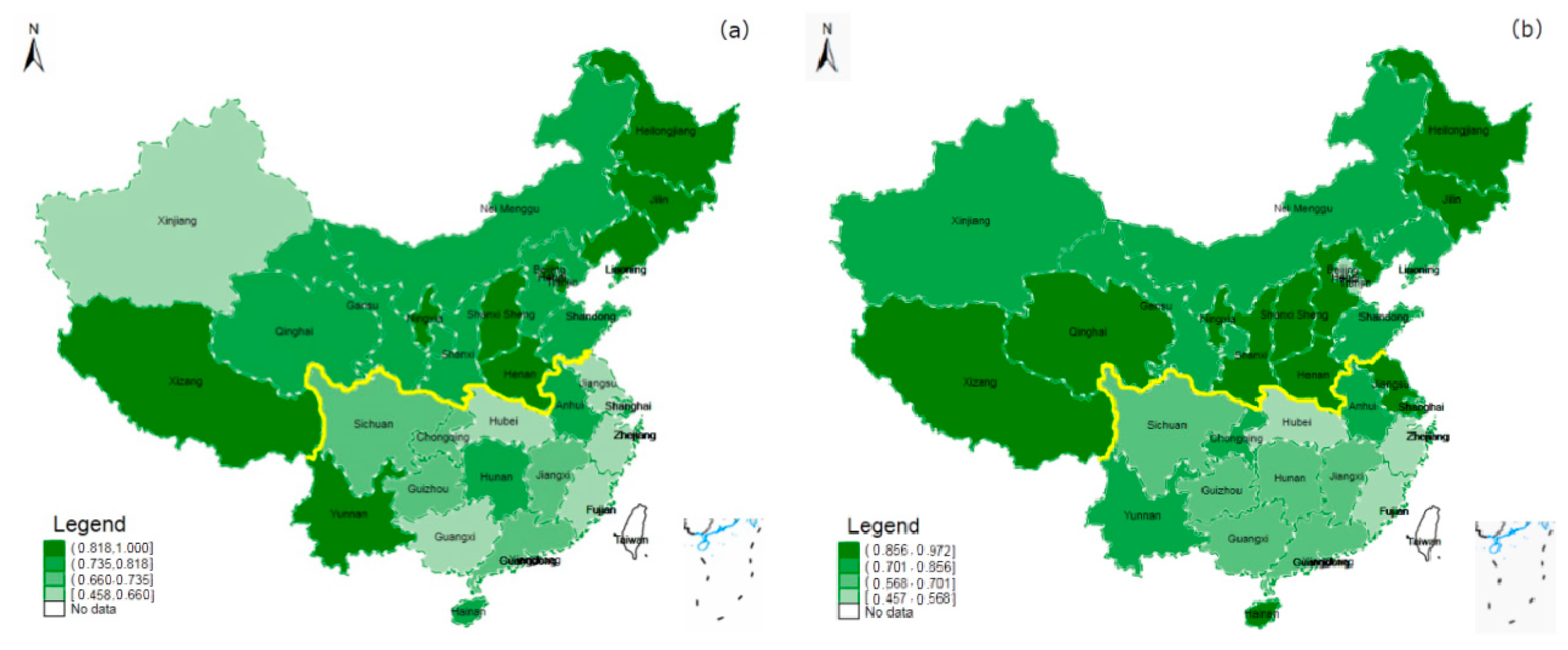
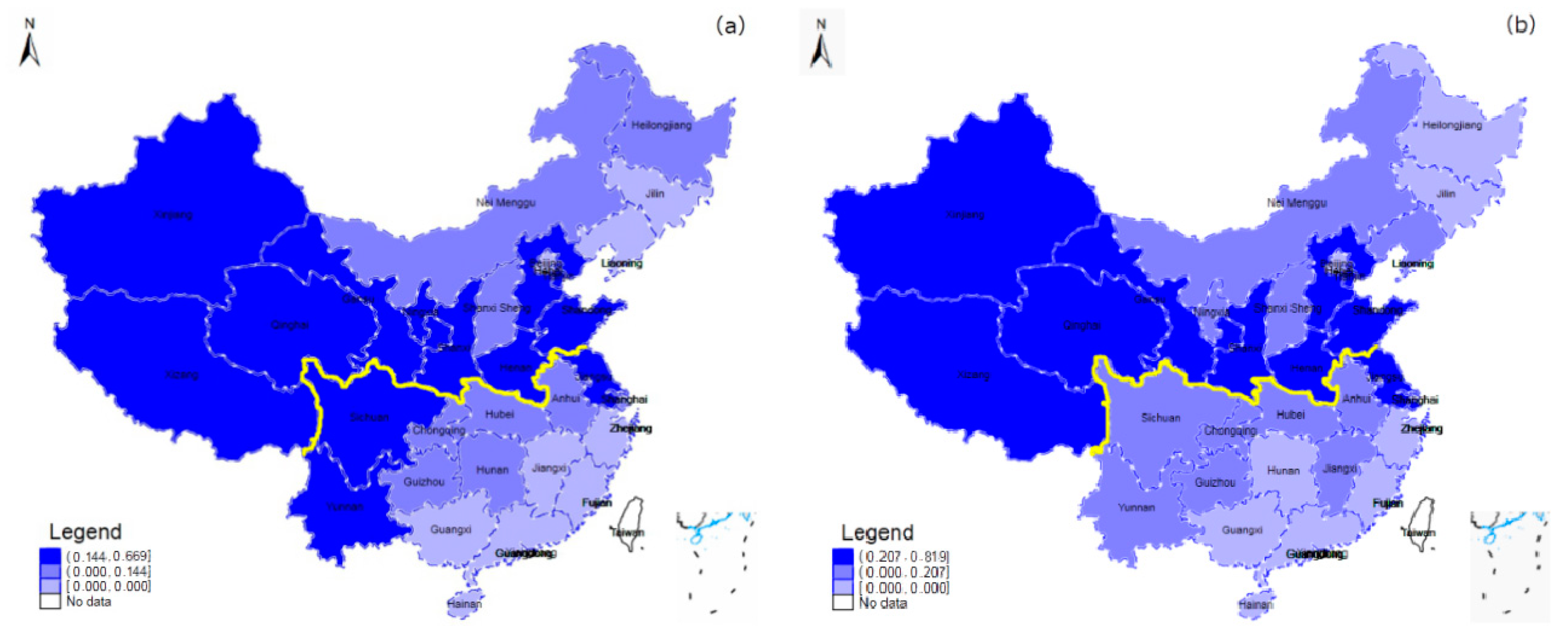
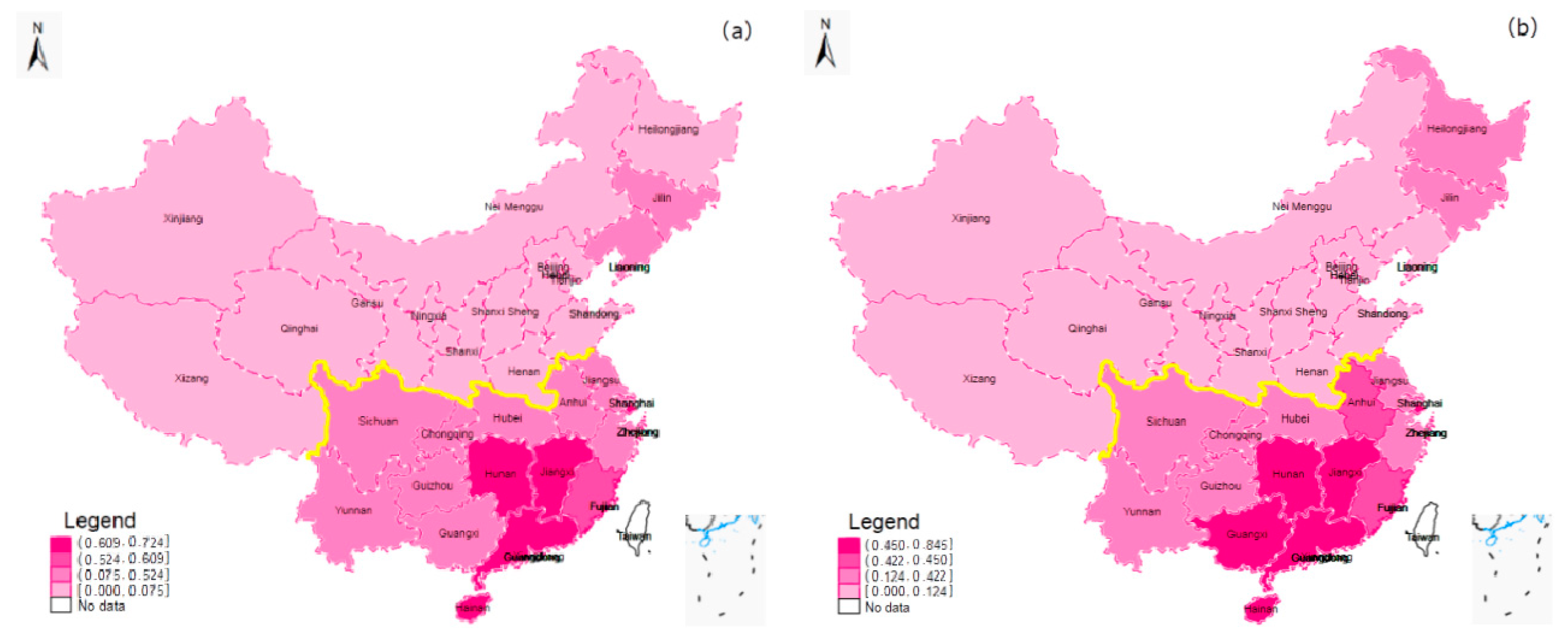
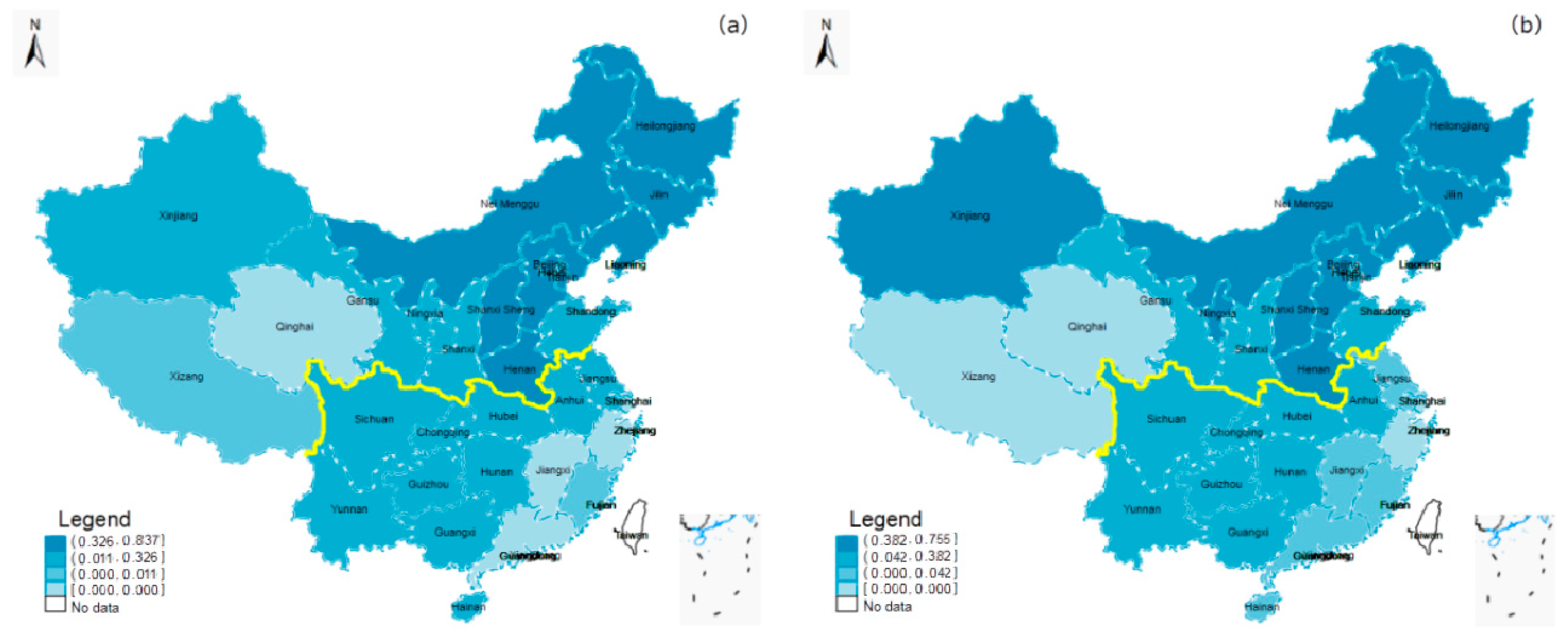
| Variables | Variable Description | Mean | Std. | Min | Max |
|---|---|---|---|---|---|
| cropper | Sown area of food crops/sown area of food crops + sown area of cash crops | 0.77 | 0.30 | 0 | 1 |
| xiaomaiper | Wheat sown area/food crop sown area + cash crop sown area | 0.15 | 0.23 | 0 | 1 |
| daoguper | Sown area of rice/sown area of food crops + sown area of cash crops | 0.25 | 0.32 | 0 | 1 |
| yumiper | Sown area of rice/sown area of food crops + sown area of cash crops | 0.27 | 0.32 | 0 | 1 |
| mucrop | Grain crop yield per unit area (kg/mu) | 421.8 | 218.6 | 0 | 10,000 |
| outin | Grain input–output ratio (grain cost/grain income) | 0.38 | 0.57 | 0 | 54.63 |
| lng28 | Family operating income (yuan) | 9.96 | 1.31 | 4.40 | 14.982 |
| Variables | Variable Description | Mean | Std. | Min | Max |
|---|---|---|---|---|---|
| Core explanatory variables | |||||
| treated | Whether to transfer land or not (transferred = 1, not transferred = 0) | 0.3441 | 0.4751 | 0 | 1 |
| Control variables | |||||
| ind3 | Age of the head of household (years) | 52.39 | 11.43 | 0 | 90 |
| ind2 | Sex of the head of household (male = 1, female = 0) | 0.9415 | 0.2347 | 0 | 1 |
| ind7 | Education level of the head of household (years) | 6.763 | 2.536 | 0 | 20 |
| train | Whether to receive training or not (training = 1, untrained = 0) | 0.1881 | 0.3908 | 0 | 1 |
| labo | Number of family labour force (person) | 2.638 | 1.323 | 0 | 10 |
| agemean | Average age of family labour (years) | 40.29 | 7.432 | 17 | 60 |
| edumean | Average education level of family labour force (years) | 7.262 | 2.046 | 0 | 18 |
| healthmean | Average self-identified health status: 1 = excellent; 2 = good; 3 = medium; 4 = poor; 5 = incapacity | 1.484 | 0.591 | 1 | 4 |
| c2 | Contracted land area at the end of the year (mu) | 8.465 | 12.86 | 0 | 608 |
| xisuihua | Area of contracted land at the end of the year/number of cultivated land at the end of the year | 2.198 | 4.251 | 0 | 300 |
| Control variables | |||||
| lnc61 | The value of productive fixed assets owned by the family at the end of the year (yuan) | 9.095 | 1.536 | 3.89 | 15.02 |
| first | GDP of primary industry/GDP (%) | 12.88 | 4.59 | 0.6 | 36.89 |
| lnpopudensity | The population of the province/the area of the province (ten thousand people/10,000 square hectares) | 6.423 | 0.9814 | 1.81 | 9.251 |
| lnGDPdensity | The province’s GDP/the province’s area (100 million/10,000 square hectares) | 7.152 | 1.253 | 1.584 | 11.44 |
| lntoland | Total cultivated land resources in each province (thousand hectares) | 9.391 | 0.6594 | 5.71 | 10.38 |
| lnagrinvest | The total investment of each province in the primary industry (ten thousand yuan/year) | 12.79 | 0.5327 | 10.46 | 13.77 |
| Test: | Ho: The Difference in Coefficients Is Not Systematic | |
|---|---|---|
| chi2(23) = (b-B)’[(V_b-V_B)^(−1)](b-B) = 60.95 | ||
| Prob > chi2 = 0.0000 | ||
| (Model 1) | (Model 2) | (Model 3) | (Model 4) | (Model 5) | |
|---|---|---|---|---|---|
| Variables | Planting Ratio of Food Crops | Wheat Planting Ratio | Rice Planting Ratio | Corn Planting Ratio | |
| treated | −0.0118 ** | −0.0115 ** | −0.0075 *** | −0.0047 | −0.0011 |
| ind3 | 0.0001 | 0.0001 | 0.0000 | −0.0002 | 0.0003 ** |
| ind2 | 0.007 | 0.0021 | 0.0068 | 0.0094 | −0.0133 * |
| ind7 | −0.0001 | 0.0001 | −0.0013 ** | −0.0011 | 0.0013 |
| train | −0.0044 | −0.0035 | −0.0066 ** | −0.0031 | 0.0055 |
| labo | −0.0026 | −0.0025 | −0.0011 | 0.0000 | −0.0021 |
| agemean | −0.0001 | −0.0001 | −0.0003 | 0.0001 | 0.0002 |
| edumean | −0.0004 | −0.0002 | 0.0011 | −0.0019 * | 0.0011 |
| healthmean | −0.005 | −0.0041 | 0.0024 | −0.0075 ** | 0.0019 |
| c2 | 0.0003 | 0.0003 | 0.0001 | 0.0003 * | −0.0001 |
| xisuihua | −0.0024 * | −0.0024 * | −0.0018 ** | 0.0000 | 0.0008 |
| lnc61 | −0.0038 ** | −0.0036 ** | 0.0003 | −0.001 | −0.0041 *** |
| first | 0.0039 ** | 0.0012 | −0.0001 | 0.0100 *** | |
| lnpopudensity | 0.0567 | 0.0053 | 0.1116 | −0.2400 *** | |
| lnGDPdensity | 0.0167 | 0.0163 | −0.0459 | 0.0123 | |
| lntoland | 0.0838 ** | 0.1005 *** | −0.0317 | 0.0503 * | |
| lnagrinvest | 0.0515 *** | 0.0282 *** | 0.0162 * | −0.0088 | |
| Constant term | 0.8193 *** | −1.1469 | −1.3123 *** | −0.0014 | 1.1621 * |
| Time effect | control | control | control | control | control |
| Village effect | control | control | control | control | control |
| Sample size | 13,284 | 13,284 | 13,284 | 13,284 | 13,284 |
| F-test | 2.341 | 3.240 | 5.885 | 2.706 | 19.91 |
| R-square | 0.00528 | 0.00908 | 0.0164 | 0.00760 | 0.0533 |
| Northern Region | Southern Region | |||||||
|---|---|---|---|---|---|---|---|---|
| (Model 1) | (Model 2) | (Model 3) | (Model 4) | (Model 5) | (Model 6) | (Model 7) | (Model 8) | |
| Variables | Grain Planting Ratio | Wheat Planting Ratio | Rice Planting Ratio | Corn Planting Ratio | Grain Planting Ratio | Wheat Planting Ratio | Rice Planting Ratio | Corn Planting Ratio |
| treated | −0.0062 | −0.0123 *** | 0.0041 | −0.0076 | −0.0186 *** | −0.0035 | −0.0134 * | 0.0037 |
| ind3 | 0.0005 * | 0.0002 | 0 | 0.0002 | −0.0003 | −0.0002 | −0.0004 | 0.0004 ** |
| ind2 | 0.0435 *** | 0.0129 | −0.0035 | 0.0213 | −0.0172 | 0.0022 | 0.0169 | −0.0297 *** |
| ind7 | 0.0012 | −0.0025 ** | −0.0004 | 0.0028 | −0.0013 | −0.0005 | −0.0022 | 0.0007 |
| train | 0.0161 * | 0.0038 | 0.0026 | 0.0126 | −0.0194 ** | −0.0132 *** | −0.0089 | −0.0008 |
| labo | −0.0032 | −0.0003 | −0.0017 | −0.0004 | −0.0027 | −0.0020 * | 0.0014 | −0.0039 *** |
| agemean | 0.0007 | −0.0002 | 0.0003 * | 0.0007 | −0.0012 ** | −0.0003 | −0.0002 | −0.0004 |
| edumean | 0.0042 ** | 0.0023 * | 0.001 | 0.0012 | −0.0039 ** | 0.0005 | −0.0043 ** | 0.0005 |
| healthmean | 0.0027 | 0.0035 | −0.0043 * | 0.0056 | −0.0096 * | 0.0014 | −0.0118 ** | 0.0000 |
| c2 | −0.0003 | 0.0001 | 0.0000 | −0.0002 | 0.0002 | 0.0001 | −0.0001 | 0.0001 |
| xisuihua | −0.0027 * | −0.0019 ** | −0.001 | 0.0014 | 0.0080 * | −0.0017 | 0.0141 *** | −0.0041 |
| lnc61 | −0.0037 * | 0.0011 | 0.0001 | −0.0063 *** | −0.0034 | −0.0005 | −0.0023 | −0.0015 |
| first | 0.0012 | −0.002 | 0.0057 *** | 0.0072 *** | 0.002 | 0.0096 *** | −0.0096 *** | 0.0031 |
| lnpopudensity | −0.1147 | −0.2447 *** | 0.1443 ** | −0.1818 | 0.072 | 0.1188 * | 0.1198 | −0.2400 *** |
| lnGDPdensity | 0.0097 | −0.0805 ** | 0.0412 * | 0.0223 | −0.0551 | 0.1090 *** | −0.2319 *** | 0.0335 |
| lntoland | 0.0467 | 0.0173 | −0.0034 | 0.068 | 0.0926 * | 0.1121 *** | −0.0336 | 0.0257 |
| lnagrinvest | 0.0484 *** | −0.0016 | 0.0092 | 0.0144 | 0.0715 *** | 0.0484 *** | 0.0385 ** | −0.0105 |
| Constant term | 0.3228 | 2.0646 ** | −1.2233 ** | 0.3744 | −1.0182 | −3.2229 *** | 1.2974 | 1.3420 * |
| Time effect | control | control | control | control | control | control | control | control |
| Village effect | control | control | control | control | control | control | control | control |
| Sample size | 6623 | 6623 | 6623 | 6623 | 6661 | 6661 | 6661 | 6661 |
| F-test | 2.553 | 4.432 | 3.447 | 14.05 | 2.376 | 6.924 | 2.071 | 5.483 |
| R-square | 0.0151 | 0.0260 | 0.0203 | 0.0780 | 0.0126 | 0.0358 | 0.0110 | 0.0286 |
| (Model 1) | (Model 2) | (Model 3) | |
|---|---|---|---|
| Variables | Grain Yield per Unit Area | Grain Input–Output Ratio | Agricultural Operation Income |
| treated | −0.0157 | 0.0014 | 0.1224 *** |
| ind3 | 0.0005 | −0.0041 | −0.001 |
| ind2 | 0.0048 | −0.0012 | 0.1646 *** |
| ind7 | 0.0014 | −0.0043 | −0.0043 |
| train | 0.0206 | 0.0018 | 0.1527 *** |
| labo | 0.0062 | −0.0109 | 0.0240 ** |
| agemean | 0.0003 | −0.001 | 0.0021 |
| edumean | −0.0042 | 0.0014 | 0.0142 * |
| healthmean | −0.0124 | 0.0135 | −0.0325 |
| c2 | −0.0002 | 0.0002 | 0.0054 *** |
| xisuihua | 0.001 | 0.0000 | 0.0102 |
| lnc61 | 0.0077 * | 0.0137 ** | 0.3351 *** |
| first | 0.0064 | −0.0045 | 0.0093 |
| lnpopudens~y | 0.1385 | −0.6235 * | −0.2972 |
| lnGDPdensity | 0.0291 | −0.1195 | −0.1337 |
| lntoland | −0.1026 | −0.031 | 0.1125 |
| lnagrinvest | −0.0656 ** | −0.1080 ** | 0.088 |
| Constant term | 6.4039 *** | 6.8120 ** | 6.8234 |
| Time effect | control | control | control |
| Village effect | control | control | control |
| Sample size | 12,251 | 12,179 | 13,448 |
| F-test | 11.94 | 2.114 | 121.1 |
| R-square | 0.0346 | 0.00633 | 0.254 |
| North | South | North | South | |||
|---|---|---|---|---|---|---|
| (Model 1) | (Model 2) | (Model 3) | (Model 4) | (Model 5) | (Model 6) | |
| Variables | Grain Crop Yield per Unit Area | Food Input–Output Ratio | Grain Crop Yield per Unit Area | Food Input–Output Ratio | Agricultural Operating Income | Agricultural Operating Income |
| treated × time | −0.0074 | −0.0147 | −0.0251 | 0.0112 | 0.0999 *** | 0.1462 *** |
| ind3 | 0.0008 | −0.0214 | 0.0000 | 0.0095 | −0.0014 | −0.0013 |
| ind2 | −0.059 | −0.0001 | 0.0318 | −0.0023 | 0.0895 | 0.2105 *** |
| ind7 | −0.0018 | −0.0017 | 0.0027 | −0.0065 | −0.0033 | −0.0096 |
| train | 0.0273 | 0.0074 | 0.0155 | −0.0075 | −0.0269 | 0.3062 *** |
| labo | 0.0087 | −0.0115 ** | 0.0037 | −0.0114 | −0.0011 | 0.0419 *** |
| agemean | 0.0016 | −0.0005 | −0.0012 | −0.0018 | 0.0068 ** | −0.0032 |
| edumean | −0.0014 | 0.0018 | −0.0043 | 0.0024 | 0.0089 | 0.0223 * |
| healthmean | −0.02 | −0.0003 | −0.003 | 0.0326 | −0.0092 | −0.0388 |
| c2 | 0.0007 | 0.0015 * | −0.0014 | −0.0003 | 0.0137 *** | 0.0003 |
| xisuihua | −0.0025 | −0.0021 | 0.0253 ** | −0.0003 | −0.0064 | 0.0574 ** |
| lnc61 | 0.0073 | −0.0075 * | 0.0101 | 0.0349 *** | 0.3093 *** | 0.3555 *** |
| first | −0.0015 | 0.0066 | −0.0032 | −0.0266 | 0.0007 | 0.0192 |
| lnpopudensity | −0.7758 | −0.1402 | −0.0804 | −0.3552 | −1.4791 | −0.2438 |
| lnGDPdensity | 0.1382 | −0.0279 | −0.1964 | −0.0333 | 0.044 | −0.5734 |
| lntoland | −0.194 | −0.0166 | 0.0798 | −0.0123 | 0.2006 | 0.0056 |
| lnagrinvest | 0.0773 | −0.0920 *** | −0.2090 *** | −0.1065 | 0.1444 | 0.1256 |
| Constant term | 10.5447 ** | 2.716 | 9.5827 *** | 4.6859 | 11.4322 | 9.8836 |
| Time effect | control | control | control | control | control | control |
| Village effect | control | control | control | control | control | control |
| Sample size | 6278 | 6230 | 5973 | 5949 | 6793 | 6655 |
| F−test | 12.34 | 3.322 | 5.163 | 1.284 | 74.65 | 57.69 |
| R−square | 0.0718 | 0.0205 | 0.0291 | 0.00741 | 0.308 | 0.236 |
| (Model 1) | (Model 2) | (Model 3) | (Model 4) | (Model 5) | |
|---|---|---|---|---|---|
| Variables | Planting Ratio of Food Crops | Wheat Planting Ratio | Rice Planting Ratio | Corn Planting Ratio | |
| treated × time | −0.0145 *** | −0.0145 *** | −0.0058 ** | −0.0023 | −0.0027 |
| Constant term | 0.8175 *** | −1.1781 | −1.3256 *** | −0.0071 | 1.1565 * |
| Head of household characteristics | Included | Included | Included | Included | Included |
| Family labour characteristics | Included | Included | Included | Included | Included |
| Family business characteristics | Included | Included | Included | Included | Included |
| Province characteristics | Exclude | Included | Included | Included | Included |
| Time effect | Included | Included | Included | Included | Included |
| Village effect | Included | Included | Included | Included | Included |
| Sample size | 13,284 | 13,284 | 13,284 | 13,284 | 13,284 |
| F-test | 2.110 | 3.069 | 4.765 | 2.737 | 21.23 |
| R-square | 0.00476 | 0.00861 | 0.0107 | 0.00617 | 0.0459 |
| Nationwide | North | South | ||||
|---|---|---|---|---|---|---|
| (Model 1) | (Model 2) | (Model 3) | (Model 4) | (Model 5) | (Model 6) | |
| Variables | Grain Crop Yield per Unit Area | Food Input–Output Ratio | Grain Crop Yield per Unit Area | Food Input–Output Ratio | Grain Crop Yield per Unit Area | Food Input–Output Ratio |
| treated×time | −0.0104 | 0.0025 | −0.0041 | 0.0008 | −0.0188 | 0.0029 |
| Constant term | 6.3855 *** | 6.8218 ** | 10.5577 ** | 2.7692 | 9.5264 *** | 4.681 |
| Head of household characteristics | Included | Included | Included | Included | Included | Included |
| Family labour characteristics | Included | Included | Included | Included | Included | Included |
| Family business characteristics | Included | Included | Included | Included | Included | Included |
| Province characteristics | Exclude | Included | Included | Included | Included | Included |
| Time effect | Included | Included | Included | Included | Included | Included |
| Village effect | Included | Included | Included | Included | Included | Included |
| Sample size | 12,251 | 12,179 | 6278 | 6230 | 5973 | 5949 |
| F-test | 11.93 | 2.114 | 12.37 | 3.303 | 5.107 | 1.280 |
| R-square | 0.0346 | 0.00633 | 0.0720 | 0.0204 | 0.0288 | 0.00739 |
| Nationwide | North | South | |
|---|---|---|---|
| (Model 1) | (Model 2) | (Model 3) | |
| Variables | Agricultural Operating Income | Agricultural Operating Income | Agricultural Operating Income |
| treated×time | 0.2004 *** | 0.1353 *** | 0.2546 *** |
| Constant term | 7.4278 | 11.5722 | 10.8056 |
| Head of household characteristics | Included | Included | Included |
| Family labour characteristics | Included | Included | Included |
| Family business characteristics | Included | Included | Included |
| Province characteristics | Included | Included | Included |
| Time effect | Included | Included | Included |
| Village effect | Included | Included | Included |
| Sample size | 13,448 | 6793 | 6655 |
| F-test | 124.2 | 75.19 | 60.03 |
| R-square | 0.259 | 0.310 | 0.244 |
| (Model 1) | (Model 2) | (Model 3) | (Model 4) | (Model 5) | |
|---|---|---|---|---|---|
| Variables | Planting Ratio of Food Crops | Wheat Planting Ratio | Rice Planting Ratio | Corn Planting Ratio | |
| treatedg rme | −0.0131 ** | −0.0130 ** | −0.0071 ** | −0.0026 | 0.0001 |
| Constant | 0.7949 *** | 0.9356 | 0.3329 | −0.2336 | 0.6899 |
| Head of household characteristics | Included | Included | Included | Included | Included |
| Family labour characteristics | Included | Included | Included | Included | Included |
| Family business characteristics | Included | Included | Included | Included | Included |
| Province characteristics | Exclude | Included | Included | Included | Included |
| Time effect | Included | Included | Included | Included | Included |
| Village effect | Included | Included | Included | Included | Included |
| Sample size | 6765 | 6765 | 6765 | 6765 | 6765 |
| F-test | 2.101 | 2.176 | 3.542 | 1.644 | 6.080 |
| R-square | 0.00754 | 0.0101 | 0.0126 | 0.00591 | 0.0215 |
| Nationwide | North | South | ||||
|---|---|---|---|---|---|---|
| (Model 1) | (Model 2) | (Model 3) | (Model 4) | (Model 5) | (Model 6) | |
| Variables | Grain Crop Yield per Unit Area | Food Input–output Ratio | Grain Crop Yield per Unit Area | Food Input–output Ratio | Grain Crop Yield per Unit Area | Food Input–output Ratio |
| Treated × time | −0.0009 | 0.0044 | −0.0081 | −0.0010 | 0.0084 | 0.0052 |
| Constant term | 3.4025 | 6.8607 ** | −4.194 | 8.7016 | 9.7326 * | 6.0731 * |
| Head of household characteristics | Included | Included | Included | Included | Included | Included |
| Family labour characteristics | Included | Included | Included | Included | Included | Included |
| Family business characteristics | Included | Included | Included | Included | Included | Included |
| Province characteristics | Exclude | Included | Included | Included | Included | Included |
| Time effect | Included | Included | Included | Included | Included | Included |
| Village effect | Included | Included | Included | Included | Included | Included |
| Sample size | 6319 | 6287 | 3247 | 3229 | 3072 | 3058 |
| F-test | 4.682 | 2.751 | 5.074 | 2.305 | 3.238 | 2.347 |
| R-square | 0.0227 | 0.0135 | 0.0495 | 0.0232 | 0.0304 | 0.0223 |
| Nationwide | North | South | |
|---|---|---|---|
| (Model 1) | (Model 2) | (Model 3) | |
| Variables | Agricultural Operating Income | Agricultural Operating Income | Agricultural Operating Income |
| treated × time | 0.2133 *** | 0.1620 *** | 0.2493 *** |
| Constant term | 12.0414 | 18.6515 | 18.5448 |
| Head of household characteristics | Included | Included | Included |
| Family labour characteristics | Included | Included | Included |
| Family business characteristics | Included | Included | Included |
| Province characteristics | Included | Included | Included |
| Time effect | Included | Included | Included |
| Village effect | Included | Included | Included l |
| Sample size | 6830 | 3461 | 3369 |
| F-test | 71.75 | 44.25 | 35.95 |
| R-square | 0.251 | 0.303 | 0.245 |
Publisher’s Note: MDPI stays neutral with regard to jurisdictional claims in published maps and institutional affiliations. |
© 2021 by the authors. Licensee MDPI, Basel, Switzerland. This article is an open access article distributed under the terms and conditions of the Creative Commons Attribution (CC BY) license (http://creativecommons.org/licenses/by/4.0/).
Share and Cite
Leng, Z.; Wang, Y.; Hou, X. Structural and Efficiency Effects of Land Transfers on Food Planting: A Comparative Perspective on North and South of China. Sustainability 2021, 13, 3327. https://doi.org/10.3390/su13063327
Leng Z, Wang Y, Hou X. Structural and Efficiency Effects of Land Transfers on Food Planting: A Comparative Perspective on North and South of China. Sustainability. 2021; 13(6):3327. https://doi.org/10.3390/su13063327
Chicago/Turabian StyleLeng, Zhihua, Yana Wang, and Xinshuo Hou. 2021. "Structural and Efficiency Effects of Land Transfers on Food Planting: A Comparative Perspective on North and South of China" Sustainability 13, no. 6: 3327. https://doi.org/10.3390/su13063327






